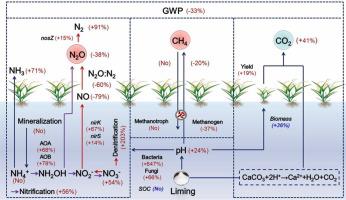Agriculture, Ecosystems & Environment ( IF 6.0 ) Pub Date : 2022-09-21 , DOI: 10.1016/j.agee.2022.108182 Hui-Min Zhang , Zhi Liang , Yong Li , Zhao-Xiong Chen , Jin-Bo Zhang , Zu-Cong Cai , Lars Elsgaard , Yi Cheng , Kees Jan van Groenigen , Diego Abalos

|
Acidic soils cover about 30% of the world’s land. Liming is a management practice applied worldwide to reduce the negative effects of acidification on soil fertility and plant growth. Liming also affects the biotic and abiotic soil properties controlling the production and consumption of the greenhouse gases (GHGs) carbon dioxide (CO2), nitrous oxide (N2O) and methane (CH4). Although our understanding of how liming regulates net GHG emissions is increasing, the impact of liming on soil biological drivers of GHG emissions has not been quantitatively synthesized. Here we conducted a global meta-analysis using 1474 paired observations from 124 studies to explore the responses of GHG emissions to liming, with a focus on soil biological factors. We show that the N2O mitigation capacity of liming could be linked to (i) increases in bacterial abundance of N2O reductase genes (NosZ) and decreases in fungi:bacteria ratio, both contributing to a lower N2O:N2 product ratio of denitrification; and (ii) reductions in soil mineral nitrogen (N) via stimulation of plant N uptake. The limited evidence available indicates that liming reduced CH4 emissions and the abundance of methanogens, but it had no effect on CH4 uptake and abundance of methanotrophs. Liming-induced increases in soil CO2 emissions can be explained by higher heterotrophic and/or autotrophic respiration. The strong coupling between liming effects on GHG emissions and on soil microbial communities involved in GHG production and consumption can be used to identify strategies to reduce GHGs in response to liming, and to improve process-based models for better predictions of soil GHG emissions.
中文翻译:

石灰改变土壤中的温室气体通量:生物驱动因素的荟萃分析
酸性土壤覆盖了全球约 30% 的土地。石灰是一种在世界范围内应用的管理实践,用于减少酸化对土壤肥力和植物生长的负面影响。石灰还影响生物和非生物土壤特性,控制温室气体 (GHG) 二氧化碳 (CO 2 )、一氧化二氮 (N 2 O) 和甲烷 (CH 4 ) 的产生和消耗。尽管我们对石灰如何调节温室气体净排放的了解正在增加,但石灰对温室气体排放的土壤生物驱动因素的影响尚未定量综合。在这里,我们使用来自 124 项研究的 1474 对观察结果进行了一项全球荟萃分析,以探索温室气体排放对石灰的反应,重点是土壤生物因素。我们证明了 N石灰的2 O 缓解能力可能与 (i) N 2 O 还原酶基因 ( NosZ ) 细菌丰度的增加和真菌:细菌比率的降低有关,这两者都有助于降低反硝化的 N 2 O:N 2产物比率;(ii) 通过刺激植物吸收氮来减少土壤矿物氮 (N)。现有的有限证据表明,石灰减少了 CH 4排放和产甲烷菌的丰度,但对 CH 4的吸收和甲烷氧化菌的丰度没有影响。石灰引起的土壤 CO 2增加排放可以通过更高的异养和/或自养呼吸来解释。石灰对温室气体排放的影响以及对参与温室气体生产和消费的土壤微生物群落之间的强耦合可用于确定减少温室气体以响应石灰的策略,并改进基于过程的模型以更好地预测土壤温室气体排放。











































 京公网安备 11010802027423号
京公网安备 11010802027423号